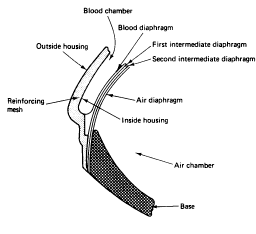go to WEEK 3 Problem 1 2 3 4 5 Demo Online Course Support
MSE 5090: Case Studies in Material Selection
Week 3 - Material Selection Process
Weighted Property Index Methods - Problem 1
The development of cardiac assistance devices and other instrumentation and components that come in contact with the cardiovascular system requires materials that will perform well in a physiological environment. One particularly difficult application is the diaphragm for the blood pump in an artificial heart. This application is to be made of elastomer that will undergo cyclic deformations and/or flexing while in contact with blood. Even a 3-y implantation of a heart will involve in excess of 100 million cycles (equivalent to a frequency of) Hz). Diaphragm for an Artificial Blood Pump4
(a) State the other desirable properties of a material for use in making the pump diaphragm.
(b) Compare and contrast the properties of two named elastomers for this application.
(c) Give a short list of other candidate elastomers(a) The other desirable properties required of a material for use in making the pump diaphragm are high flexibility, high strength, high ductility, long in vivo durability, high reliability and safety, excellent biocompatibility with blood and tissues, and resistance to degradation by the enzymes papain and urease, which are present during the inflammatory response [1]. Papain is known to be closely related to cathespsin B, a thiol endopeptidase, which is released by the cells of the inflammatory response. Urease is found in leukocytes. The pump diaphragm material should also be resistant to propagation of surface-initiated cracks, which could lead to premature failure [2]. Cracks may also serve as sites for thrombus formation or as initiation points for calcification.
Figure Q5.l presents a cross section of the widely used artificial heart, the Jarvik 7, showing the position of the blood pump diaphragm relative to the other components.
Figure Q5.I Cross section of the Jarvik 7 artificial heart a. The two named elastomers to be compared for this application are Hexsyn, a sulfur-vulcanized hydrocarbon rubber, essentially a polyhexene, and Pellethane, an extruded thermoplastic polyether urethane elastomer. A compilation of the relevant properties of these two materials is given in Tables Q5. 1 and Q5.2. Here are some comments on each.
TABLE Q5.1 PROPERTIES OF TWO ELASTOMERS FOR CARDIAC ASSIST DEVICESa
aAll values at average blood temperature. 37°C.
Property Hexsyn Pellethane Tensile strength (MPa) 12 54 Elongation (%) 284 380 Modulus of elasticity, 100% (MPa) 3.14 5.03 Density (kg m-3) 1047 1114 Tear strength, Trouser (kN m -1) 2.63 9.28 Tear energy (J) 3.03 16.61 Glass transition temperature (°C) —52 —57 Single-cycle tension permanent set (%) 100% strain 5.7 13.3 20% strain 3.6 3.2 Fatigue test permanent set (%) 100% extension 22 17 150% extension 43 45 Stress relaxation, at 100% strain (kPa) 149 165 Permeability (mg * mm s -1 m -2) 25 375 Sources: Goodyear Tire and Rubber, Akron. Oh. (for Hexsyn); Upjohn Co.. Torrance, Calif. (for Pellethane).
TABLE 05.2 FATIGUE RESISTANCE OF CANDIDATE ELASTOMERSa
aExpressed as % strain at 50% failure, in blood at 37°C.
Material Uncut Specimens Cut-Initiated Specimensb Hexsyn 190 19 Pellethane 210 7
bSpecimens were cut with a razor blade to give a precise I-mm cut in the gage center of the specimen.Source: C. R. McMillin, "Accelerated fatigue testing of elastomers in blood and related environments," in M. Szycher (ed.). Biocompatible Polymers, Metals, and Composites, Lancaster, Pa.: Technomic Publishing Co., 1983.
(c) Other adequate elastomers for this application include Biomer*, which is polyether urethane [3]; Avcothane 51, a block copolymer of 90% polyether urethane and 10% polydimethyl siloxane [2]; and Santoprene, a commercial sheet thermoplastic rubber based on polypropylene.Hexsyn: Attributes include low permeability to fluids, the ability to be compression-molded, low raw material cost, and ready availability from more than one supplier in medical-grade form. Drawbacks include the potential for a large amount of permanent set, poor creep properties, low modulus of elasticity, and low tear strength. Pellethane: The attractive features of this inexpensive, commercially available material include its ability to be formed into parts by a wide variety of methods, such as extrusion, blow molding, film casting, and injection molding. Disadvantages include a rapid decrease in its fatigue resistance in the presence of stress raisers, high permeability to fluids, and nonavailability in a specific, closely controlled medical grade. REFERENCES
1. S. K. Phua et al., "Biodegradation of a polyurethane in vitro," J. Biomed. Mater. Res. 21, pp. 231—246, 1987.
2. D. J. Parkins et al., In Viva Degradation of a Polyurethane, St. Paul, Minn.: Cardiac Pacemakers, inc., 1981.
3. K. Hayashi et al., "Mechanical stability of elastomeric polymers for blood pump applications," J. Biomed. Mater. Res. 19, pp. 179—193, 1985.
4.Lewis , G. Selection of Engineering Materials, Prentice Hall , 1990, pp 260 -263 this and the following examples were taken from the examples given in this excellent book, which has a number of more detailed cases and suggestions for case studies.

Last update 9-12-98
